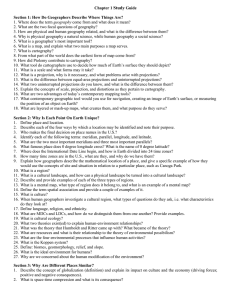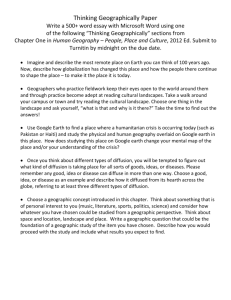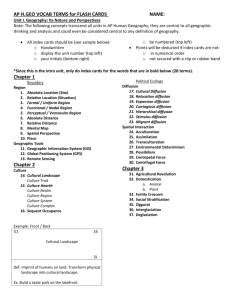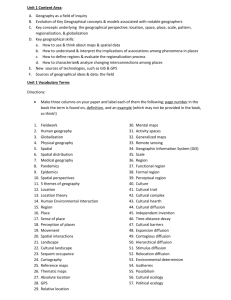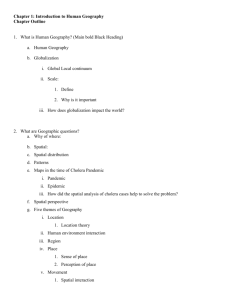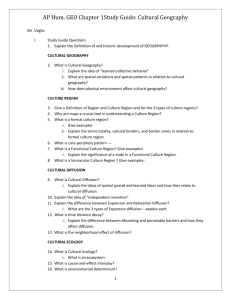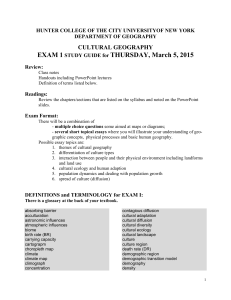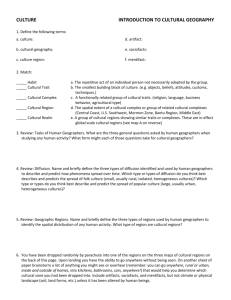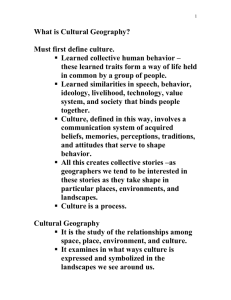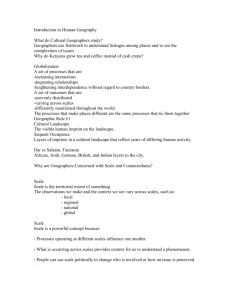Unit 1 Terms
advertisement
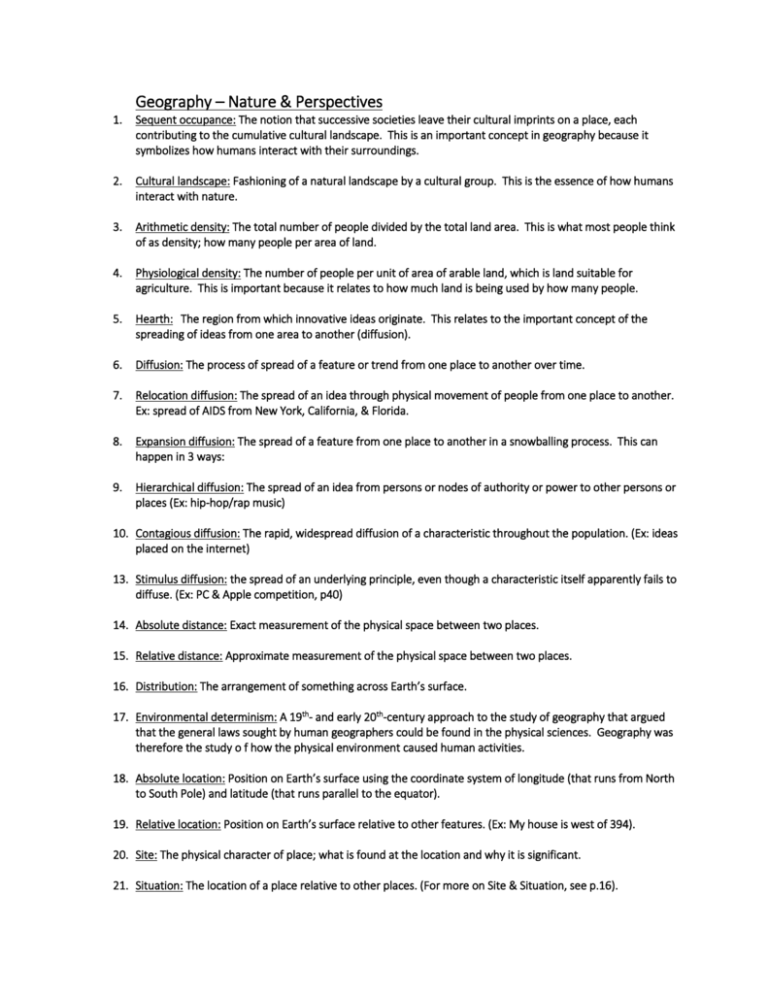
Geography – Nature & Perspectives 1. Sequent occupance: The notion that successive societies leave their cultural imprints on a place, each contributing to the cumulative cultural landscape. This is an important concept in geography because it symbolizes how humans interact with their surroundings. 2. Cultural landscape: Fashioning of a natural landscape by a cultural group. This is the essence of how humans interact with nature. 3. Arithmetic density: The total number of people divided by the total land area. This is what most people think of as density; how many people per area of land. 4. Physiological density: The number of people per unit of area of arable land, which is land suitable for agriculture. This is important because it relates to how much land is being used by how many people. 5. Hearth: The region from which innovative ideas originate. This relates to the important concept of the spreading of ideas from one area to another (diffusion). 6. Diffusion: The process of spread of a feature or trend from one place to another over time. 7. Relocation diffusion: The spread of an idea through physical movement of people from one place to another. Ex: spread of AIDS from New York, California, & Florida. 8. Expansion diffusion: The spread of a feature from one place to another in a snowballing process. This can happen in 3 ways: 9. Hierarchical diffusion: The spread of an idea from persons or nodes of authority or power to other persons or places (Ex: hip-hop/rap music) 10. Contagious diffusion: The rapid, widespread diffusion of a characteristic throughout the population. (Ex: ideas placed on the internet) 13. Stimulus diffusion: the spread of an underlying principle, even though a characteristic itself apparently fails to diffuse. (Ex: PC & Apple competition, p40) 14. Absolute distance: Exact measurement of the physical space between two places. 15. Relative distance: Approximate measurement of the physical space between two places. 16. Distribution: The arrangement of something across Earth’s surface. 17. Environmental determinism: A 19th- and early 20th-century approach to the study of geography that argued that the general laws sought by human geographers could be found in the physical sciences. Geography was therefore the study o f how the physical environment caused human activities. 18. Absolute location: Position on Earth’s surface using the coordinate system of longitude (that runs from North to South Pole) and latitude (that runs parallel to the equator). 19. Relative location: Position on Earth’s surface relative to other features. (Ex: My house is west of 394). 20. Site: The physical character of place; what is found at the location and why it is significant. 21. Situation: The location of a place relative to other places. (For more on Site & Situation, see p.16). 22. Space Time Compression-: The reduction in the time it takes to diffuse something to a distant place, as a result of improved communications and transportation system. 23. Friction of Distance: is based on the notion that distance usually requires some amount of effort, money, and/or energy to overcome. Because of this "friction," spatial interactions will tend to take place more often over shorter distances; quantity of interaction will decline with distance. 24. Distance Decay: The diminishing in importance and eventual disappearance of a phenomenon with increasing distance from its origin. Typically, the farther away one group is from another, the less likely the two groups are to interact. (Electronic devices such as the internet and e-mail have aided in eliminating barriers to interaction between people who are far from each other. 25. Networks: defined by Manuel Castells as a set of interconnected nodes without a center. 26. Connectivity: The relationships among people and objects across the barrier of space. Geographers are concerned with the various means by which connections occur. 27. Accessibility: The degree of ease with which it is possible to reach certain location from other locations. Accessibility varies from place to place and can be measured. 28. Space: Refers to the physical gap or interval between two objects. 29. Spatial Distribution: Physical location of geographic phenomena across SPACE 30. Size: Is the estimation or determination of extent. 31. Scale: Representation of a real-world phenomenon at a certain level of reduction or generalization. In cartography, the ratio of map distance to ground distance, indicated on a map as a bar graph, representative fraction, and/or verbal statement. 32. Formal Region: (uniform) or homogenous region is an area within which everyone shares in common one or more distinctive characteristics. The shared feature could be a cultural value such as a common language, or an environmental climate. 33. Functional Region: (nodal region) Area organized around a node or focal point. The characteristic chosen to define a functional region dominates at a central focus or node and diminishes in importance outward. This region is tied to the central point by transportation or communication systems or by economic or functional associations. 34. Vernacular Region: (Perceptual Region) is a place that people believe exists as a part of their cultural identity. Such regions emerge from peoples informal sense of place rather than from scientific models developed through geographic thought. (Often identified using a mental map- which is an internal representation of a portion of the Earth’s surface) 35. Possibilism: The physical environment may limit some human actions, but people have the ability to adjust to their environment. 36. Pattern: A common property of distribution, which is the geometric arrangement of objects in space. Some features are organized in a geometric pattern, whereas others are distributed irregularly. Geographers observe that many objects form a linear distribution, such as the arrangement of houses along a street or stations along a subway line. 37. Place Name: Often referred to as a places toponym (the name given to a place on Earth.
